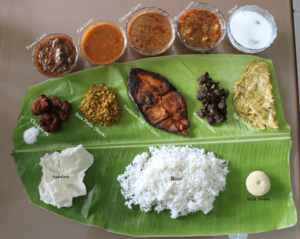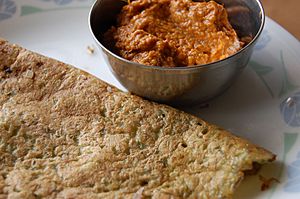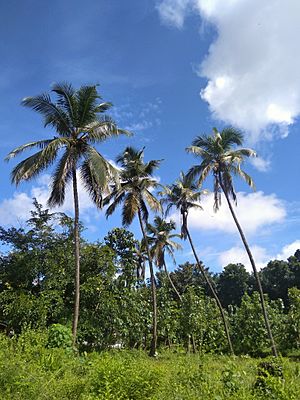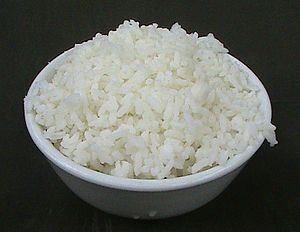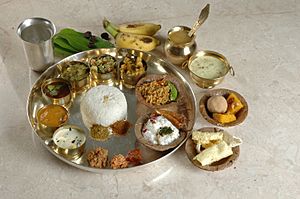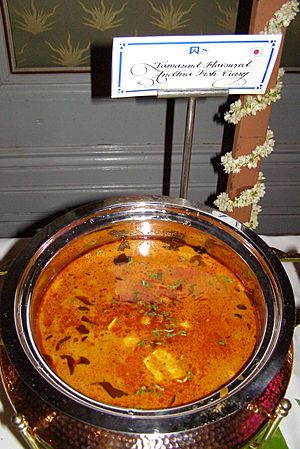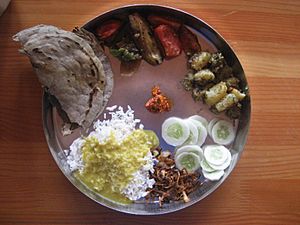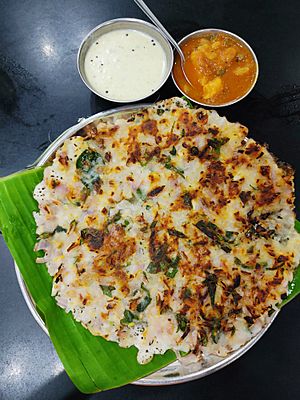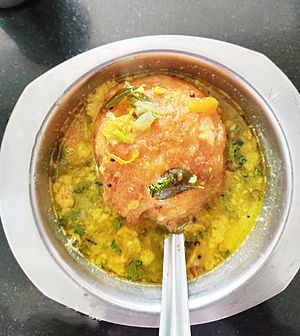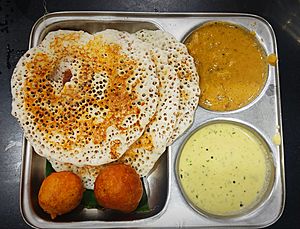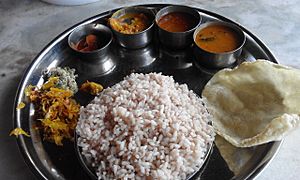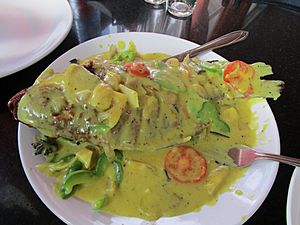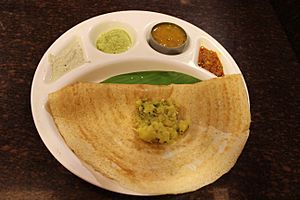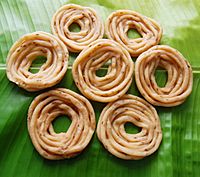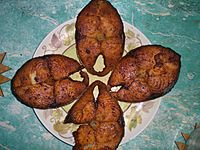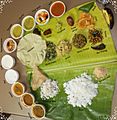South Indian cuisine facts for kids

South Indian cuisine includes the delicious foods from five states in southern India: Andhra Pradesh, Karnataka, Kerala, Tamil Nadu, and Telangana. It also covers the foods from the union territories of Lakshadweep, Pondicherry, and the Andaman and Nicobar Islands. Each state has its own special vegetarian and non-vegetarian dishes. You can find unique main meals, snacks, desserts, and drinks in every region.
Contents
Special Ingredients from South India
Did you know that coconuts first came from Southern India? From here, they traveled to places like Europe, Arabia, and Iran over many centuries. Portuguese traders even brought Indian coconuts to the Americas!
Black pepper also started its journey in India, specifically on the Malabar Coast. This area is still famous for growing lots of Malabar pepper. Long ago, people from different countries like Greece, Egypt, and China came to India just for spices like cinnamon and black pepper. These spices were traded from ancient ports like Muziris.
What makes South Indian food similar across these states? They all use rice as a main food. They also use lentils, many different spices, dried red and fresh green chilies, and of course, coconut! You'll also find local fruits and vegetables like tamarind, plantain, jackfruit, snake gourd, garlic, and ginger.
How South Indian Cuisines Are Alike and Different
All five South Indian states share many cooking traditions. The biggest difference is often how spicy the food is! For example, Kerala's Malabari cooking is famous for its tasty seafood. Hyderabad, a city with a rich history, has food that can be spicy, sour, or sweet. Their dishes often use nuts, dried fruits, and special spices like saffron.
Most people in Kerala, Tamil Nadu, and parts of Karnataka and Andhra Pradesh eat a lot of rice. In southern Karnataka, people also enjoy ragi (finger millet). But in North Karnataka, you'll find more bajra (pearl millet) and sorghum. The state of Telangana also uses more jowar and pearl millet in its meals.
Telugu Food (Andhra Pradesh and Telangana)
The food from Andhra Pradesh and Telangana is known for being the spiciest in all of India! They use a lot of chili and tamarind, which makes dishes both hot and tangy. Most dishes are made with vegetables or lentils.
Rice is the main food here. A special lentil soup called Sambar is very popular. A traditional Andhra meal usually has five different dishes. To cool down after a spicy meal, people often eat curd (yogurt) at the end.
Local Styles of Telugu Food
The Telugu-speaking areas have different food styles. In the Telangana region, which is near Central India, people eat more flatbreads (roti) made from sorghum and pearl millet.
The Rayalaseema area, bordering Karnataka and Tamil Nadu, has food similar to those states. The Andhra coastal region, with its long coastline, has unique seafood dishes.
Hyderabad, the capital of Telangana, has its own special food style. This "Hyderabadi cuisine" was loved by the Nizams (old rulers). It's similar to royal Indian food but spicier! Famous Hyderabadi dishes include kacche gosht ki biryani (raw meat biryani), dum ka murgh (chicken cooked Hyderabadi style), baghara baingan (eggplant), and achaari subzi (vegetable curry with pickle flavor).
In Telangana, millet breads are common, while rice is the main food in Andhra and Rayalaseema. Many curries (called koora), snacks, and sweets have different names and ways of being made across these regions.
Popular Telugu Dishes
Vegetarian Dishes
- Breakfast (Tiffins): Pesarattu (mung bean pancake), attu, bobbatlu, pulihora (tamarind and lemon rice), upma.
- Pickles (Pachhallu): Raw mango pickle, gongura pachadi, tomato pachadi, ginger pachadi.
- Curries (Kooralu): Gutti vankaya (stuffed eggplant), bendakaya fry (okra fry).
- Lentil Dishes (Pappu): Palakura pappu (spinach-lentil stew), dosakaya (yellow cucumber-lentil stew).
- Sour Stews (Pulusu): Gongura pulusu (sorrel leaf stew).
- Thin Soups (Chaaru): Tomato chaaru, miriyala chaaru (pepper soup), ulava chaaru.
- Snacks: Sakinalu, chekkalu, murukulu.
- Sweets: Pootarekulu, kaaja, ravva laddu, boondi laddu, ariselu.
Non-Vegetarian Dishes
Hyderabadi biriyani and other meat dishes are a big part of Hyderabadi cooking. Other Telugu areas have many lamb and chicken dishes. Coastal regions offer lots of seafood. Some dishes include kodi iguru (chicken stew), chepa pulusu (fish stew), and prawn curry. It's said that the Nizam of Hyderabad had 49 types of Biryanis!
Karnataka Food
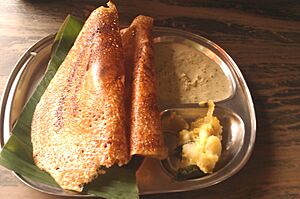
Karnataka has a very wide range of foods. Popular South Indian breakfast items like idli, vada, and masala dosa might have started in the temple town of Udupi in Karnataka. Karnataka's traditional food is known for being milder in spice compared to other South Indian states. It uses a lot of jaggery (unrefined sugar) and palm sugar, with less chili powder. However, North Karnataka food can be very spicy! Since many people in Karnataka are vegetarian, vegetarian food is very popular.
Karnataka's food history goes back a long time. It mixes flavors and cooking styles from its neighbors like Kerala, Andhra Pradesh, Tamil Nadu, and Maharashtra.
Regional Karnataka Food Styles
North Karnataka Food
In North Karnataka, the main grains are sorghum and pearl millet, along with rice. Flatbreads (rottis) made from these grains are eaten with side dishes like eggplant, fresh salads, and spiced lentils. People also enjoy spicy powders called chutney pudis and pickles. This region is known for its very spicy food. Meat is eaten less here than in other parts of India. You can find tasty dishes like Jolada rotti and Thallipeet with spicy curries like Enne kathirikai. Sweets include Belgaum kunda and holige.
Coastal Karnataka Food
Coastal Karnataka food uses a lot of seafood, coconut, and coconut oil. Rice is the main food. Gravies called "gassi" (made from chicken, fish, or other meats) are eaten with rice. Lentils and vegetables cooked with coconut and spices, called huli, are also served with rice. A thin soup like saaru is also popular. Meals often include vegetable side dishes called palya, yogurt-based tambli, and pickles. Special breakfast foods include bun, goli bajji, and patrode. Mangalorean food is unique, using curry leaves and coconut in most dishes. Famous dishes are Neer dosa, Kori Rotti, and Mangalore Buns.
Kodava Food (Coorg)
Coorgi food is very different from other Karnataka foods. It's known for using a lot of pork and other meats. Kokum (a sour fruit) is used a lot in their cooking. Rice and rice-based dishes like kadambattu (steamed rice dumplings) are still the main foods.
South Karnataka Food (Old Mysore)
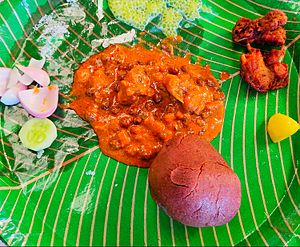
South Karnataka food mainly uses ragi (finger millet) and rice. Ragi mudde (ragi dumplings) or steamed rice are the main part of a meal. These are often served with vegetable side dishes (palya) and soups called saaru. Common items include gojju (a thick sweet and sour gravy), uppinakai (pickles), and huli (a spiced sour lentil soup). Special home-style foods include bassaaru (a spiced lentil soup) and masoppu (mashed spiced greens).
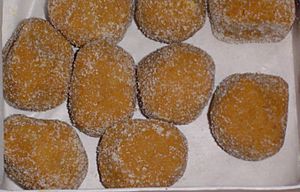
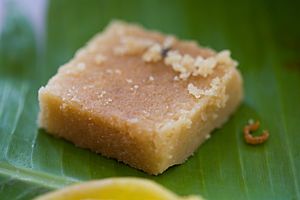
Avare kal (Indian beans) are popular in winter and used in many dishes. Rice dishes often served as a second course include bisi bele baath, chitranna (lemon rice), and puliyoggare (tamarind rice). You can also try Ragi mudde, Ragi rotti, Akki rotti, and Benne dose.
Curd (yogurt) is a common part of every meal in Karnataka, usually eaten with rice at the end. Buttermilk with spices is also served, especially in summer. Ghee (clarified butter) and butter are used for cooking, especially during festivals.
Udupi Hotels
Udupi hotels helped make South Indian food famous across India. These small restaurants serve affordable vegetarian breakfast dishes all day. The famous masala dose started in Udupi cuisine and became popular through Udupi restaurants. Udupi food uses local fruits, vegetables, grains, and beans. It's entirely vegetarian, using jaggery, rice, and coconut.
Karnataka Dishes
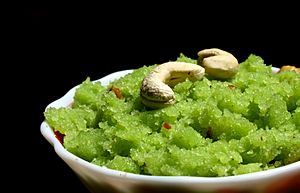
Karnataka has many sweets like Belagavi Kunda, Mysore pak, obbattu/holige, dharwad pedha, and chiroti. Many of these sweets use jaggery instead of refined sugar. Other dishes include Kosambari (salad), Palya (vegetable side dish), Raita, huli (lentil and vegetable broth), and Chitranna.
Some typical breakfast dishes are masala dose, ragi rotti, akki rotti, Vangibath, khara baath, kesari baath, davanagere benne dose, uppittu, and rave idli.
Lunch items include huli (sambar), thili (rasam), kootu, gojju, bisi bele baath, chitranna, and kosambri (salad).
Snacks include kodabale, chakkali, nippattu, maddur vade, and goli bajji. Kids often love the tangy Tamarind Chigali.
Kerala Food

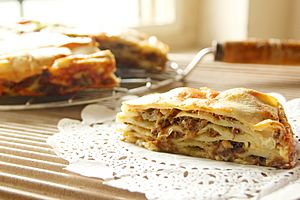
Kerala food is very diverse, often grouped by different communities. Since Kerala exports a lot of coconuts, almost all dishes use coconut in some way – as shavings, coconut oil, or coconut milk. Seafood is also very popular in coastal areas and eaten almost daily. Expect lots of coconut, chili, and spices in the delicious local recipes.
Popular Kerala Dishes: Vegetarian: Olan, paalpradaman, nendarangai chips (banana chips), aviyal, pulissery, erucherri, sambar, sadhya (a feast), rasam, kalan, upperis, pachady, and vegetable stew.
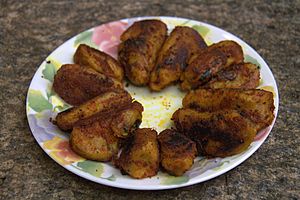
Non-Vegetarian: Kerala's food has been influenced by traders from Greece, Rome, China, Portugal, and Arab countries. While tastes differ between North and South Kerala, they use similar vegetables. Plantains, coconut, gourds, and yam are common. Dishes include shrimp coconut curry, various fish curries, fish fry, chicken fry with shredded coconuts, karimeen (pearl spot fish) pollichathu, chicken stew, mutton stew, and Thalassery biriyani. Kerala_Beef_Fry, also known as beef ullarthiyathu, is a popular dish across Kerala.
Malabar biriyani uses khyma rice instead of basmati rice. This biriyani is known as Thalassery biriyani.
Snacks: Upperi, payasam, banana fry (pazham pori), ullivada, kozhukkatta, unniyappam, neeyyappam, halwas, cakes, and vattayappam.
Breakfast: Puttu (with banana or kadala curry), appam (velayappam, palappam) with curry, vegetable stew, fish molee, chicken or mutton stew, duck roast, egg curry, and idiyappam with kadala curry. Also, porotta with chicken curry, and idli or dosai with chutney.
A typical Kerala-style masala dosa has shredded, cooked, and fried vegetables with Indian sauce and spices inside a thick brown dosa. It's served with hot sambhar and coconut chutney.
Tamil Nadu Food
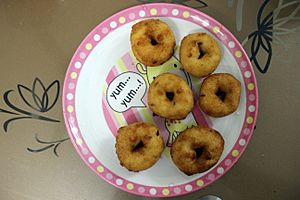
Tamil Nadu is famous for its amazing traditional food, offering a wide range of both vegetarian and non-vegetarian dishes. Each dish has its own unique flavor.
A typical Tamil meal has many spicy and non-spicy dishes. Most of these are mixed and eaten with steamed rice, which is the main food. While many Tamilians eat non-vegetarian food, they usually have vegetarian meals on most days.
Restaurants in Tamil Nadu are often called Saivam (only vegetarian food) or Asaivam (both non-vegetarian and vegetarian food). Fresh coffee and tea are always served.
Tamil cuisine groups dishes into five main types:
Gravy Dishes to Mix with Rice
These dishes are meant to be mixed with rice. They include kuzhambu, sambar, paruppu (lentils), rasam, and thayir (yogurt). There are many kinds of kuzhambu, like puli kuzhambu (tamarind gravy) and vaththal kuzhambu. Non-vegetarian kuzhambu like chicken and fish curries are also mixed with rice.
Side Dishes
These foods go along with the main rice mixtures. They include kootu (vegetables in a wet style), poriyal (vegetables in a dry style), varuval (fried dishes), thokku (thick gravy), aviyal, oorukaai (pickles), and Pappadam (crispy fried or baked lentil wafers).
Snacks
This group includes quick snacks and their dips. Examples are vada, bonda, bajji (fritters), various chutneys, and thayir Pachadi (yogurt mixed with vegetables).
Desserts
These are rich and sweet dishes served at the end of a meal. They include payasam (pudding), jigarthanda, kesari bhaat, pongal, palkova, and many other Indian sweets.
Light Meals (Tiffin)
This category includes "tiffin" or light meals, like idlis, dosa, poori, pongal, uppma, idiyappam, aappam, adai, parotta, and paniyaram. These are usually eaten for breakfast or early dinner, not as a main midday meal.
Tamil meals often start with a light breakfast, have a heavy midday meal, and a lighter dinner, with snacks in the evening. Rasam is mixed with rice and often eaten with crispy items. The last course is always rice with curd or yogurt, usually with pickles.
Side dishes are served throughout the meal and can be refilled. Desserts are served last. After the meal, people might have bananas and paan (betel leaves with nuts and lime), which helps with digestion.
Non-vegetarian Tamil meals are similar, but the first courses might be replaced by different biryanis and non-vegetarian gravies.
Meals are often served on a banana leaf. Pickles and appalams are common additions.
Tamil food believes in six tastes: sweet, sour, salty, bitter, pungent (spicy), and astringent (a drying taste). A traditional meal tries to include all six for good nutrition and digestion.
- Sweet: milk, butter, ghee, rice, honey.
- Sour: limes, lemons, yogurt, tamarind.
- Salty: salt, pickles.
- Bitter: bitter gourd, turmeric.
- Pungent: chili peppers, ginger, black pepper, mustard.
- Astringent: beans, lentils, cauliflower, cabbage.
Chettinad Cuisine
Chettinad cuisine comes from the Chettinad region of Tamil Nadu. It's known for using many freshly ground spices like cumin, fenugreek, fennel, clove, and tamarind. This food is famous for its complex and rich flavors. While it's often thought of as very spicy, it's actually a balanced mix of flavors.
Chettinad cuisine is known for its non-vegetarian dishes. The food is hot and strong, made with fresh ground spices, and often served with a boiled egg. Because the region is dry, they also use sun-dried meats and salted vegetables. The meats eaten are usually fish, prawn, lobster, crab, chicken, and mutton. Chettiars do not eat beef or pork.
Most Chettinad dishes are eaten with rice or rice-based items like dosais, appams, idiyappams, and idlis. The Chettinad people also learned to make a special rice pudding from Burma, using sticky red rice.
Popular Chettinad Dishes: Vegetarian: idli, sambar, vadai, rasam, dosa, thayir sadam (yogurt rice), thayir vadai (yogurt-soaked fritters), kootu, poriyal, murukku, uthappam, idiappam, appalam (fried lentil crisps), and fresh thayir pachidi.
Non-Vegetarian: Karuvattu kuzhambu (salted, dried fish in sauce), Chettinad pepper chicken, fish fry, and kanji (rice porridge) with "old fish" gravy.
Images for kids
See also
 In Spanish: Gastronomía del sur de la India para niños
In Spanish: Gastronomía del sur de la India para niños


